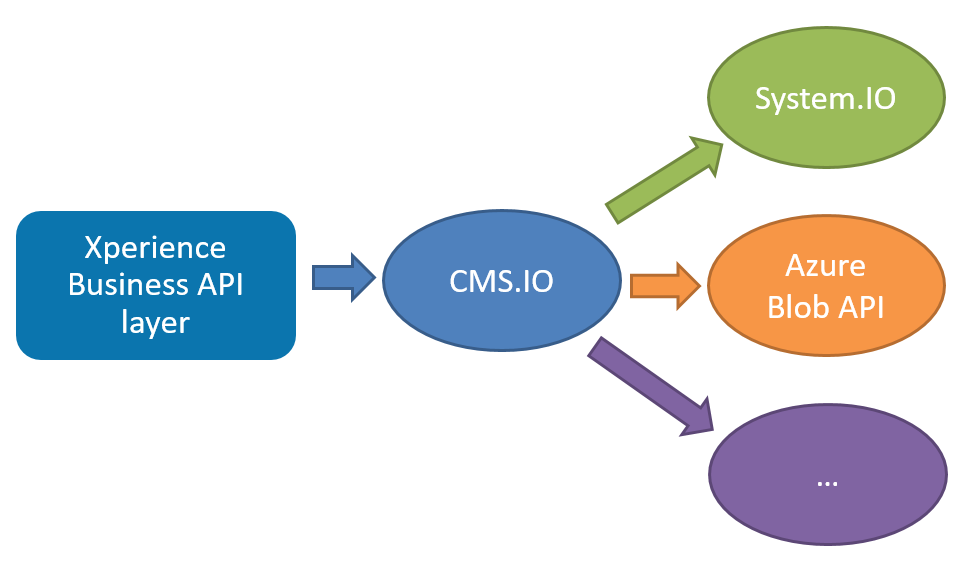Files API and CMS.IO
CMS.IO is a namespace that serves as an interlayer between the business layer of Xperience and storage used for physical files. CMS.IO is used throughout the system instead of the default System.IO library provided by .NET in order to be compatible with various types of storage systems.
CMS.IO contains abstractions that access file storage by means of a provider object. Depending on the storage type that you use for your files, the system utilizes one of the following providers:
- File system storage – used by default for files stored in the Windows file system. The provider is a wrapper for the standard
System.IOlibrary. - Azure storage – used when storing files in Azure Blob storage.
- Amazon storage – used when storing files in the Amazon S3 storage service.
The following diagram demonstrates how CMS.IO accesses different types of file storage via provider objects:

This documentation assumes that you are familiar with the System.IO library and know how to use it to manipulate files and directories. Learn how to use System.IO.
CMS.IO
Working with CMS.IO is in most aspects the same as working with System.IO. We recommend using CMS.IO instead of System.IO in your code so that your custom code doesn’t depend on a single file system type.
Similarities between CMS.IO and System.IO
Classes
- Directory
- DirectoryInfo
- File
- FileInfo
- FileStream
- Path
- StreamReader
- StreamWriter
- StringReader
- StringWriter
Enumerations
- FileAccess
- FileAttributes
- FileMode
- FileShare
- SearchOption
Other classes and enumerations
For classes and enumerations not implemented by CMS.IO, we recommend using the standard implementations from the System.IO namespace (for example System.IO.Stream). Xperience expects these types across its API.
Differences between CMS.IO and System.IO
The most significant difference is in the creation of new instances of objects. Instead of a constructor, each class contains a New method, which accepts the same parameters as the class’ constructor.
The following example shows how to write text into a file. You can see that the instance of the FileInfo class is created using the New method. Note that the StreamWriter class used in the example is also a member of CMS.IO, not System.IO.
using CMS.IO;
...
FileInfo fi = FileInfo.New("MyFile.txt");
using (StreamWriter sw = fi.CreateText())
{
sw.WriteLine("Hello world!");
}
There are a number of types that can be found in System.IO, but are not implemented in CMS.IO. These include seldom used classes, class members, and methods. Additionally, CMS.IO doesn’t define exceptions. You need to use exceptions from System.IO, or implement custom ones.
Helper methods
CMS.IO contains additional methods and properties which simplify operations with files and directories. The following list describes the most useful methods:
DirectoryHelper class
- void DeleteDirectoryStructure(string path) – deletes the directory specified by the path parameter and all subdirectories.
- void EnsureDiskPath(string path, string startingPath) – checks whether all directories between
startingPathandpathexist and creates them if necessary. - void EnsurePathBackslash(string path) – adds a backslash to the end of the path, if missing.